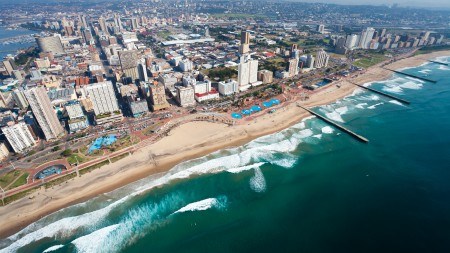To some extent, technology has made flexi-workers of us all, and it is having a profound effect on how and where we choose to live.
We all know how technology has changed our lives, forever. Since the 1990s, when fax machines were overtaken by the internet and email, cell phones, laptops, video-conferencing, smart phones, social networks and tablets have arrived with ever-increasing speed to alter the way we interact with one another, and when we do so. These days, just about anyone with a cell phone, for example, can listen to the latest pop song, find out what movies are on tomorrow or download a recipe for a never-fail chocolate soufflé – and is quite likely to do any or all of those things while lining up their next business appointment, taking a tea break during a training course or getting directions to a customer’s office.
Technology is also taking us from the sublime to the super trendy. Children in the remotest locations are able to go to school and be taught via satellite TV linkups, farmers deep in the country can now plan their planting and watering according to long-range weather forecasts, and tsunami warning systems are saving thousands of lives on far-flung islands. At the same time, people are buying handheld TV monitors just because it’s fashionable now to watch your favourite shows on the bus. Or is it just that? Perhaps handheld TVs – and people working on laptops, phones and tablets in coffee shops, internet cafés, aeroplanes, parking lots, on holiday or at home, any time of the day or night, is just evidence of how we are using technology to multitask and get more done in a shorter time. People who sit in the traffic listen to the radio, so why not watch TV on the train? Why not answer emails while you wait to pick the kids up from school? And why not turn a couple of boring hours on a plane to good account by drafting your new business plan?
In short, technology has had a profound effect on how and when we think about work as well as on how we fit it into and around the rest of our lives. We all have, to varying degrees, become flexi-workers and this, in turn, brings about major changes in the real estate market.
In the ’80s and ’90s, there was a rapid decentralisation of offices from the traditional CBDs to suburban office parks and estates, mostly driven by executives who no longer wanted to contend with traffic congestion and the problems of urban decay in the city centres. This was followed in many areas by further residential decentralisation – and the large-scale development of cheaper townhouse and cluster accommodation in formerly exclusive areas like Sandton – because employees were getting tired of the long and often expensive haul to the decentralised company headquarters. Consequently, we now have city centres surrounded by a myriad smaller business centres or ‘office nodes’. As fuel prices have continued to rise and traffic congestion has continued to worsen, many of these have spawned their own shopping malls, schools, residential estates and the other accoutrements of fully fledged, self-contained precincts – rather like the medieval walled towns – that residents seldom have to leave for any reason.
The bustling Fourways area north of Johannesburg is a good example of this type of development, as is Umhlanga Ridge to the north of Durban. Both have grown up around early office and retail developments and are now not only quite independent of their parent cities but considered very desirable places to live. In Fourways, for example, there have been more than 100 home sales in the past year and the average freehold home price has risen, according to Lightstone, from R1.73 million to R1.74 million. In the nearby Dainfern estate, where the first stands were sold for about R60 000 or R70 000 because the estate was in the ‘middle of nowhere’, there have been 103 home sales in the past year, at an average price of R3.5 million. In Umhlanga ridge, there have been 110 home sales at an average price of R1.1 million, while in Umhlanga Rocks – the older part of town close to the beach – there have been more than 100 home sales in the R2 million bracket this year.
And this brings us to the live/work/play concept that was much bandied-about in the early 2000s as a tenet of the ‘new urbanism’ but in fact is just a way of acknowledging that, influenced by technology, many of us now have a very different way of looking at how we spend our days. It is no longer eight hours for the job, eight hours for me and the family and eight hours for sleep, but more like 16 or 17 hours of being awake to do everything i need to do today, including work, and seven or eight hours for sleep, possibly some of that on the bus home. In this new work paradigm, everything we do is integrated and we don’t want to waste time getting from point A to point B between tasks.
In any case, developers were quick to like the concept and it soon resulted in new developments like Melrose Arch in Johannesburg, Century City in Cape Town and Umhlanga’s New Town Centre, which were specifically created as live/work/play precincts from the outset. In Century City, the Lightstone statistics show, there were more than 230 home sales in the past 12 months, at an average price of R1.27 million for sectional-title properties, and R2.54 million for freehold homes. There have also been some multimillion rand sales of penthouses in both Melrose Arch and Century City recently, and demand is apparently rising for the luxury apartments in the new live/ work/play area developing around Sandton Square.
Meanwhile, the growing desire not to waste time and money on transport is also – somewhat ironically – revitalising SA’s old city centres at a rapid rate. Exclusive enclaves and gated estates are of course beyond the reach of most young working people, but they are increasingly realising that the money they pay for transport, such as bus or taxi fares or what they would pay for a car, fuel and insurance each month, could be better used to rent or even buy a flat ‘in town’, within walking distance of work, shops, entertainment venues – and many of their friends’ homes. In Hillbrow and Berea in Johannesburg, for example, about 220 homes have been sold in the past year, at an average price of around R150 000. In Pretoria’s inner city, Sunnyside and Arcadia areas, more than 850 homes have been sold, at an average price of about R330 000, with the number being boosted by parents buying accommodation for students at nearby Tuks University.
In Cape Town especially, and increasingly in Johannesburg and Pretoria, it is now also very trendy for people in techno-creative careers – photography, film, advertising, design, marketing and even music and dance – to combine their working and living spaces in one unit, and even have shared recreational facilities like a pool, squash courts or gym in the same building. Such multistorey ‘loft’ apartments, largely styled after those in the Soho and TriBeca areas of Manhattan, generally sell for more than R1.5 million, while ‘normal’ apartments in Cape Town are currently selling for an average of R890 000.
However, for buy-to-let investors, the real message here is that both central and decentralised areas that lend themselves to the live/work/ play lifestyle look like the best places to buy rental properties for the foreseeable future. Rentals achievable in these areas will generally be higher than the rentals you can get for similar units elsewhere because of the convenience offered. And back out in the suburbs, while there is still a growing demand for homes with ready-made office, consulting or light manufacturing space for people who want to run their businesses or practices from home (telework), the really big trend now is to live close to the new rapid transport stations – just like their counterparts in London, Paris and New York have been doing for decades.
In Gauteng, parts of Centurion, Midrand and Kempton Park have been given a whole new lease of life because of their proximity to the Gautrain stations, while in Cape Town, the IBRT has made parts of the Western Seaboard much more attractive as residential options for those who still have to work in the city. In Halfway Gardens in Midrand, there have been 150 sectional title sales in the past year (following the opening of the Gautrain line between Johannesburg and Pretoria) at an average price of R616 000. In the same period, the average sectional title price in Tableview on the Western Seaboard has gone up from R747 000 to R759 000, while the freehold home price has gone from R1.11 million to R1.32 million, largely in response to the introduction of the MyCiti rapid bus service between tableview and the CBD.
Why? Because once again these transport systems allow people to telescope more activities into their waking hours. They are not only a much cheaper, greener and more pleasant way to travel, but you can read or knit or do your taxes or go through all your emails so that your trip to work is not just a ride but a really productive interlude. Indeed, so great is the drive to multitask and make the best use of our time now that commuting distance and method is rapidly becoming the biggest consideration after price in our choice of residential location.
To read more about property trends, please go to www.junction.co.za




